
Pitru Paksha 2024 is an important period for Hindus as they come together to honor their ancestors through the sacred Shradh rituals. This 16-day period holds immense spiritual significance as it marks the time when the souls of deceased ancestors are believed to descend from the spiritual world to receive offerings from their descendants. One of the most intriguing aspects of Shradh ceremonies is the role of crows, who are seen as the messengers of the ancestors.
During Pitru Paksha, families across India place food offerings outside for crows, believing that these birds serve as intermediaries between the living and the dead. If a crow accepts the offering, it signifies that the ancestors have received their share of food and blessings, ensuring peace for their souls. But why are crows specifically chosen for this role?
In this detailed exploration of Pitru Paksha 2024, we’ll delve deep into the importance of crows in Shradh rituals, their symbolic meaning, and the spiritual connection that they represent.
Pitru Paksha 2024 is scheduled to begin on September 17, 2024, and will conclude on October 2, 2024, with the observance of Sarva Pitru Amavasya, also known as Mahalaya Amavasya. These 16 days fall during the waning phase of the moon in the Hindu month of Bhadrapada (September-October).
According to Hindu scriptures, Pitru Paksha period is set aside for paying homage to deceased ancestors by performing the Shradh rituals. These offerings help ensure the spiritual well-being of ancestors’ souls, known as Pitras, and in return, the living descendants receive their blessings for prosperity, health, and happiness.
Performing the Shradh rituals during Pitru Paksha is a crucial part of Hindu dharma (religious duty). It symbolizes respect, gratitude, and the acknowledgment of the debts we owe to our forebears. Every day of Pitru Paksha is dedicated to ancestors who passed away on the corresponding lunar Tithi (day), and Shradh is performed to offer food, water, and prayers to their souls. But amidst these ceremonies, the crow holds a special place, symbolizing the key role it plays in bridging the gap between the living and the departed.
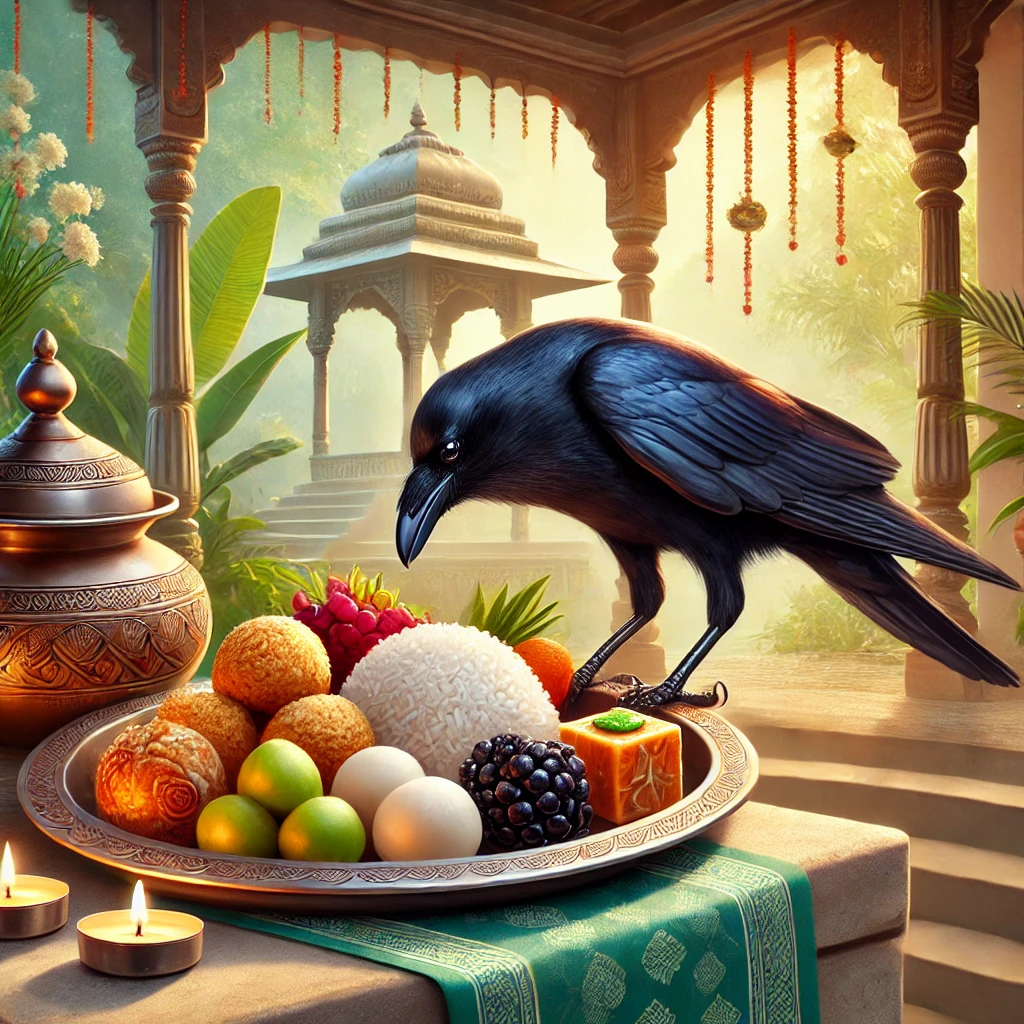
Crows have always held a special place in Hindu tradition, especially when it comes to rituals like Shradh during Pitru Paksha 2024. Their importance stems from ancient beliefs and stories passed down through generations. In Hinduism, crows are seen as more than just birds; they are believed to have a direct connection to the afterlife and the spirits of our ancestors.
According to these beliefs, crows act as messengers for Yama, the god of death. When families perform Shradh rituals, the food offerings made to crows are thought to reach their departed loved ones through the birds. This idea is rooted in ancient Hindu scriptures like the Puranas and epics such as the Mahabharata and Ramayana, where the deep spiritual link between crows and ancestors is highlighted.
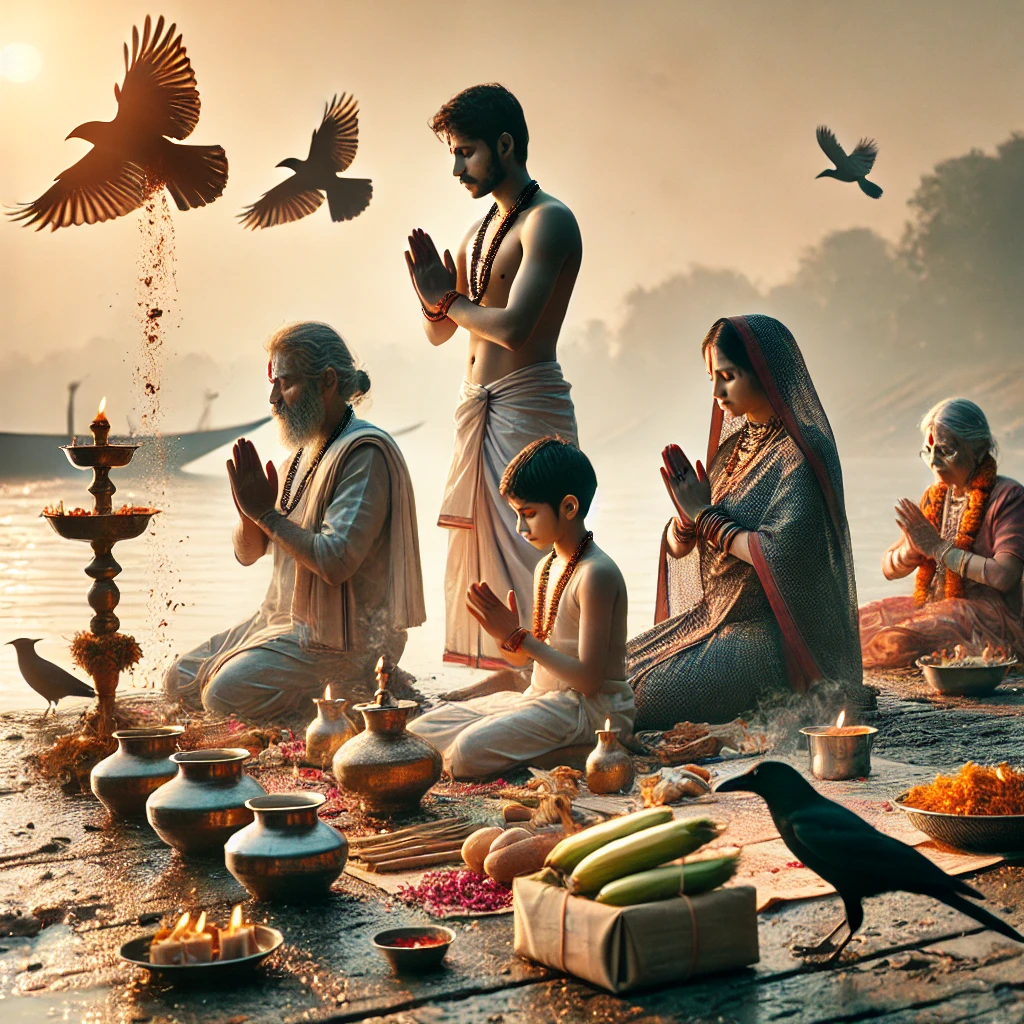
In Hindu mythology, crows are often seen as vehicles or messengers for Yama, who rules over death and the afterlife. It is believed that when a crow eats the food offered during Shradh, it means that the ancestors have received their portion of the meal. The crow acts like a bridge between the world of the living and the world of the dead, transferring the spiritual energy of the offering to the souls of the ancestors, ensuring they are satisfied and at peace in the afterlife.
In many families, a big part of the Shradh ceremony during Pitru Paksha is waiting for the crows to come and eat the food. If a crow accepts the offering, it is considered a very positive and auspicious sign, indicating that the ancestors are pleased with the rituals being performed. It is believed to be a blessing for the family, signifying that their prayers and offerings have been accepted. However, if the crow does not eat the food, it is often seen as a sign that the ancestors might not be fully satisfied. In such cases, the family may choose to offer additional prayers or perform more rituals to ensure their ancestors find peace and contentment.
This simple yet profound ritual highlights the deep respect and connection that Hindus maintain with their ancestors. Crows, in this context, become a powerful symbol of communication between two worlds—the living and the departed. Through them, families not only feed their ancestors but also seek their blessings and forgiveness, reinforcing the strong familial bonds that transcend life and death.
In Hinduism, crows hold a special place, not just as birds but as powerful spiritual symbols. Their significance goes beyond what meets the eye—they are believed to connect the material world we live in with the spiritual realm of the afterlife. During Pitru Paksha 2024, their role becomes even more profound as they act as bridges between the living and the dead, playing a crucial part in Shradh rituals. Let’s take a closer look at why crows are so important in this tradition.
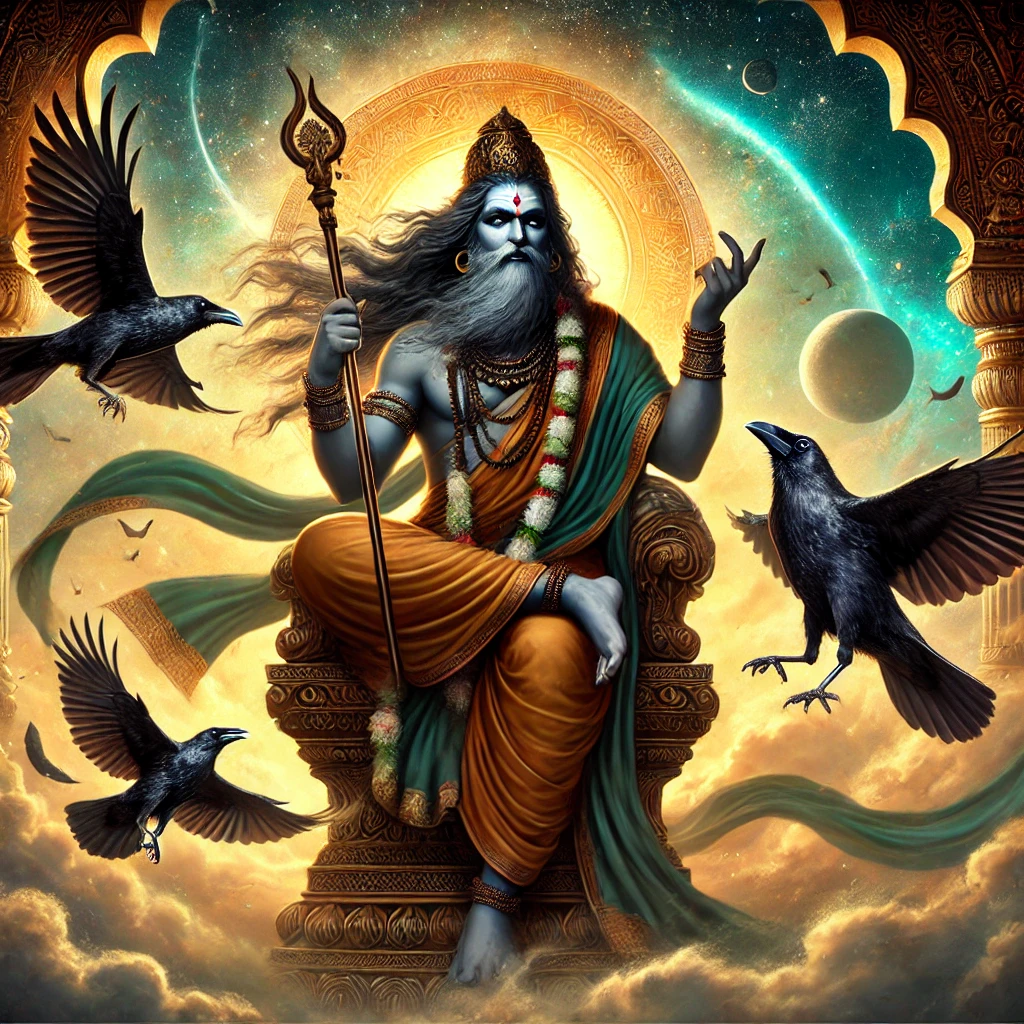
Crows are thought to have a direct link to Yama, the Hindu god of death. Yama’s responsibility is to oversee the dead, and he is often portrayed as a strict yet fair judge of souls. According to Hindu belief, crows act as his messengers during Pitru Paksha. When food is offered to crows during Shradh rituals, it’s not just about feeding a bird. The crows are seen as spiritual carriers, delivering the essence of the food to the souls of the ancestors. In this way, the offerings made by the living reach the deceased, ensuring that their spirits are remembered, respected, and nourished.
It’s as if the crows serve as a direct line of communication between our world and the world of the ancestors. Without them, it would be much harder to feel connected to those who have passed on. By feeding a crow, we are symbolically feeding our ancestors through Yama’s divine messengers, showing that they are still an important part of our lives.
Crows are also seen as symbols of deep spiritual wisdom in Hindu culture. Their dark feathers, sharp eyes, and keen intelligence have long made them figures associated with mystery and the unknown. Crows are often spotted around cremation grounds or funeral sites, which adds to their connection with death and the afterlife. But rather than being symbols of fear, they represent an understanding of the cyclical nature of life and death- a natural process where one phase flows into the other.
Their presence reminds us that death is not something to be feared but a part of the larger spiritual journey that every soul undertakes. Just as the crow flies between the earthly and spiritual worlds, we too are constantly moving between different phases of existence- birth, life, death, and rebirth.
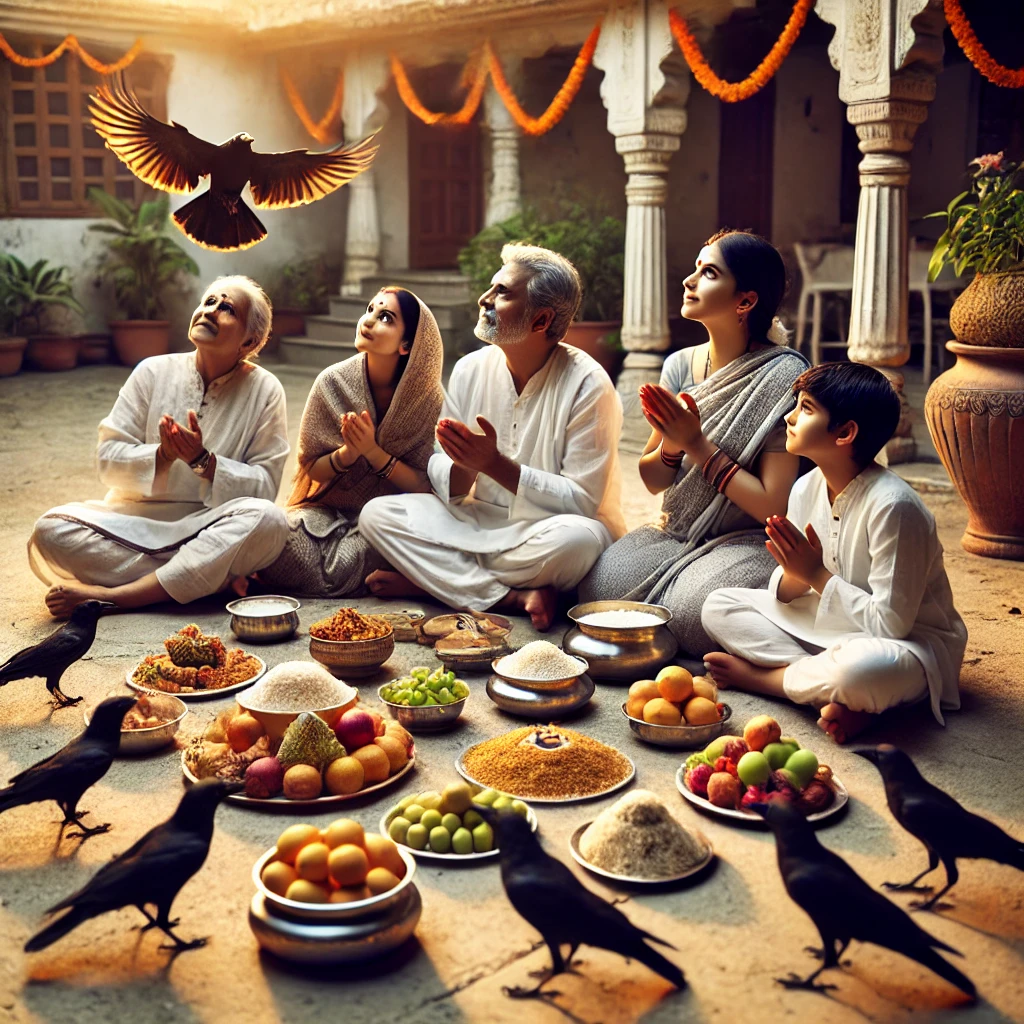
During Pitru Paksha, crows take on an even more significant role as the physical link between the living and their ancestors. When a crow swoops down to eat the food offerings, it is believed to be a direct sign that the ancestors have accepted the food and prayers. The crow’s actions serve as proof that the ancestors are present, watching over their descendants and receiving the offerings with gratitude.
This exchange between the living and the dead is more than a ritual- it’s a deeply personal act of love, respect, and remembrance. Crows, by accepting these offerings, provide reassurance that the bond between families is still alive, even after death. It reminds us that death is not a final separation, but a transition to another state of being where our loved ones continue to look after us, even if we can’t see them.
In this way, crows symbolize that connection that never truly breaks. They show us that, through our rituals and prayers during Pitru Paksha, we can still care for those who have passed, and they, in turn, continue to bless and guide us from the afterlife. It’s a comforting reminder that the cycle of life and death is ongoing, and our ancestors are always a part of us.
Hindu mythology is rich with stories that emphasize the role of crows in ancestral worship, particularly during Shradh ceremonies. Here are a few key stories that illustrate their significance:
One of the most well-known stories linking crows to Shradh comes from the epic Mahabharata. According to the legend, Karna, one of the greatest warriors of the Mahabharata, ascended to heaven after his death. However, when he arrived, he was offered gold and riches but not food. Confused, he asked Indra, the king of the gods, why he wasn’t receiving any food in heaven.
Indra revealed that while Karna had been generous throughout his life, donating gold and wealth to the poor, he had never offered food to his ancestors. To rectify this, Karna was sent back to Earth for a brief period, during which he performed Shradh and offered food to his ancestors. In this story, it was the crows who acted as the receivers of Karna’s offerings, symbolizing the ancestors’ acceptance.
This story is often cited during Pitru Paksha to emphasize the importance of feeding crows as part of the Shradh rituals. By offering food to crows, devotees ensure that their ancestors are nourished in the afterlife.
In the Ramayana, there is a lesser-known tale involving Lord Rama and a crow. While Rama and Sita were in exile, a crow, believed to be the son of Indra, attacked Sita. In retaliation, Lord Rama used a blade of grass as a weapon to protect her, and the crow fled to the corners of the Earth seeking refuge. Eventually, the crow returned to Lord Rama and asked for his forgiveness. Rama not only forgave the crow but also blessed it with a significant role in Shradh ceremonies.
This story is often referenced to explain the spiritual power of crows and their important connection to the divine and the departed.
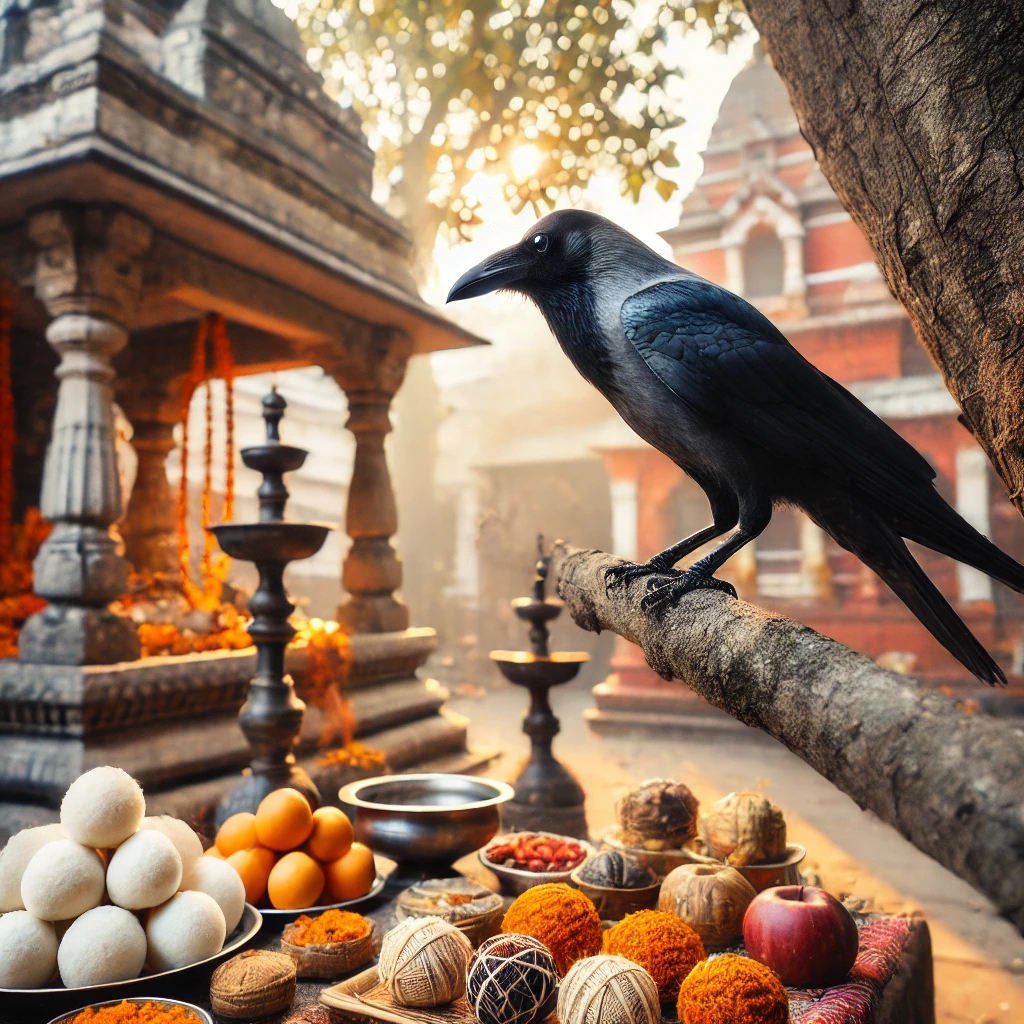
The role of crows in Shradh rituals is specific and deeply symbolic. Here is a breakdown of how families incorporate crows into their ceremonies during Pitru Paksha 2024:
One of the key rituals of Shradh during Pitru Paksha is the Pind Daan, where round balls of rice, barley, black sesame seeds, and ghee are offered to the ancestors. After the Pind Daan, the food is placed in an open area outside the home or temple, waiting for crows to consume it. In many cases, additional food items such as cooked rice, fruits, and sweets are also offered.
Alongside the food offerings, water mixed with sesame seeds is offered to crows during Tarpan. This water is poured on the ground or into a sacred vessel while specific mantras are chanted. The crows are believed to carry the spiritual energy of these offerings to the ancestors, ensuring that their thirst is quenched.
Many families choose to perform Shradh rituals at sacred locations such as Gaya, Haridwar, or Varanasi, where feeding crows during Pitru Paksha holds special significance. It is believed that performing the rituals at these holy sites amplifies their spiritual benefits, ensuring the ancestors’ peace and the family’s prosperity.
In Shradh ceremonies, much importance is placed on whether or not the crows accept the food offerings. If a crow eats the food, it is seen as a positive sign that the ancestors are pleased and have accepted the offering. This is considered highly auspicious and brings blessings to the family. However, if the crows do not consume the food, it may indicate that the ancestors are dissatisfied. This can be interpreted as a sign that more prayers or additional rituals are needed. In some cases, families might consult a priest or astrologer to perform special rites to seek the ancestors’ forgiveness and ensure their peace.
While the traditional role of crows in Shradh rituals remains largely unchanged, modern interpretations also bring in ecological and symbolic perspectives. Many Hindus see feeding crows during Pitru Paksha as a way of maintaining a connection with nature and respecting all forms of life. In this sense, crows are not only spiritual messengers but also representatives of the natural world that sustains us.
Additionally, some Hindus interpret the role of crows in Shradh as a reminder of the interconnectedness of all beings. By offering food to crows, families acknowledge that life, death, and the afterlife are all part of a greater cosmic cycle, one in which every living creature plays a role.
Pitru Paksha 2024 offers an opportunity to reconnect with our ancestors through the time-honored Shradh rituals, and at the heart of these ceremonies are the crows, whose symbolic role cannot be overstated. Acting as divine messengers, crows bridge the gap between the living and the dead, carrying offerings to our ancestors and ensuring their spiritual nourishment.
The importance of crows in Shradh rituals dates back to ancient Hindu scriptures, where their connection to Yama, the god of death, is well-documented. Whether you see them as messengers of the divine or as spiritual symbols of the afterlife, crows remain an integral part of Pitru Paksha. By offering food and prayers to these birds, we honor the souls of our forefathers, express our gratitude, and seek their blessings for the future.
As Pitru Paksha 2024 approaches, understanding and embracing the significance of crows can help deepen the meaning of the rituals we perform, ensuring that our ancestors are remembered and revered with love, respect, and devotion.
Crows are believed to be messengers of Yama, the god of death, and they carry food offerings made during Shradh rituals to the ancestors.
If a crow does not consume the food during Shradh, it may indicate that the ancestors are dissatisfied, and additional prayers or rituals may be needed.
Pind Daan is a key Shradh ritual where rice balls are offered to the ancestors. These offerings are often placed outside for crows to consume, symbolizing the ancestors’ acceptance.
Yes, priests typically recite specific Shradh mantras during food offerings and Tarpan to ensure the ancestors’ peace and satisfaction.
Feeding crows as part of ancestor worship is primarily a Hindu tradition, deeply rooted in the religion’s beliefs about the afterlife and spiritual connection with ancestors.
Shradh rituals can be performed both at home and at temples, though some prefer to perform them at sacred locations like Gaya or Haridwar for added spiritual significance.
If you liked this article or, then do write us in the comment section below.
Author – Amit Pradhan
For Astrology, Numerology, and Reiki Services – Contact us at 9324801420 or drop your queries at [email protected]
For more information Subscribe to our website to know more about such facts.
For an enquiry, write to us at [email protected]
👉If you liked this article or, then do write us in the comment section below.
For Astrology, Numerology, and Reiki Services
We also deal in original quality and certified Rudraksha, Crystals and Gems.
👉Shop Now Original Rudraksha & Crystals
For more daily updates do like and Follow Us on our Social Channels and keep visiting www.jaymahakaal.com